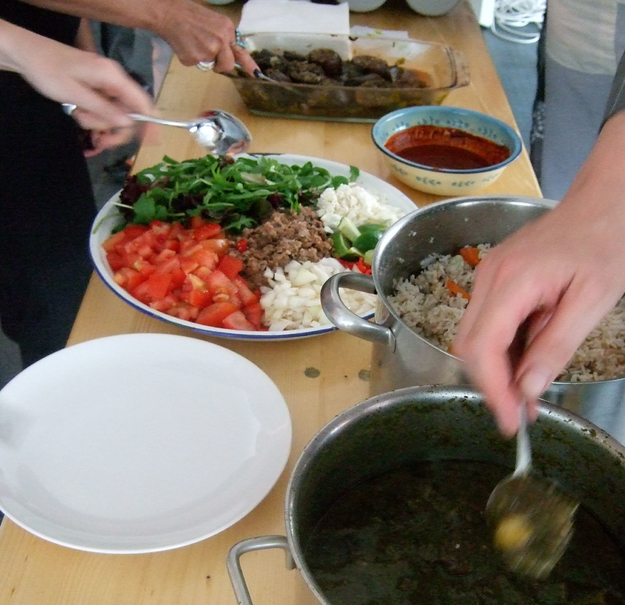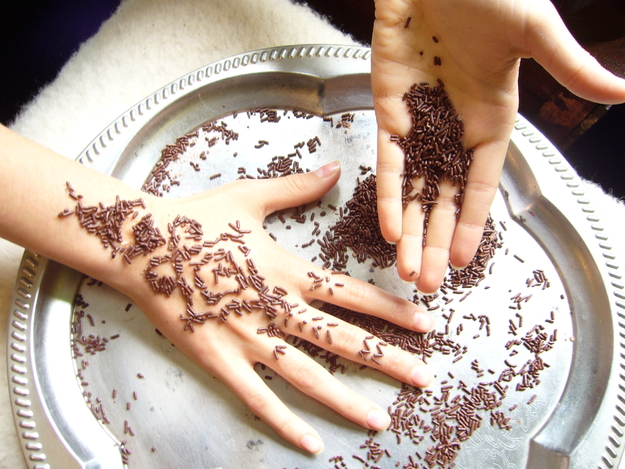Chocolate Letters
The idea directly coincides with the organizers’ concept of creating an Arabic version of the Netherlands’ Hema chain stores to publicize the release of five new Arabic fonts. By creating products with Arab inspired culture, El HEMA organizers hope to expose locals to Arab culture through script design. The proposal to create chocolate Arab letters was inspired by the traditional chocolate letters available at Hema stores during Christmas time. “Kids usually receive their initials for Christmas,” Gaeiras said.
Presentation about standardising El HEMA tags - El HEMA koopavond 7

The plan is to produce molds for all 19 shapes of the 29-letter Arab alphabet. Willem Velthoven, Mediamatic, said a chocolate company has already shown interest in producing the letters. However, with the exhibit less than 20 days away, it would be quite costly and time consuming to make molds for all 19 letters, Baeiras said. It took him one and a half days to create one mold with a kit that cost about 50 euros. Negotiations are still being made.
Similarly, measures are also being taken to produce a do-it-yourself stamp kit designed by graphic design intern Maria Hakim.
Arabisch Voedsel - El Hema koopavond 7

Design Updates
The meeting further demonstrated how up-to-speed the resourceful and talented five Arab intern designers responsible for designing El HEMA products can be.
“Hema has a new logo, so we have to do the same,” graphic design intern Wael Morcos said as he introduced a second version of El HEMA logos.
Intern Khajag Apelian, responsible for standardizing the price tags and labels for the exhibit’s products, said Hema still uses the old logo for about 90 percent of its products, but is gradually integrating their new logo design in their stores.
Bernardo made the first Arabic Chocolate Letter -

“This is the first time in my life that I can see legible Arabic tags,” Huda Smitshuijzen Abifares, El HEMA Coordinator, said of the new designs. “It’s very convincing how quick you guys reengineered the designs.”
Designer Abrar Al-Musallam and Raya Tueny also updated attendees on their latest apparel creations, which were originally displayed on the 9:30 p.m. Dutch news the night before.
“Your breasts will look beautiful with potatoes and olives” and “You’re all butter, where can I start,” will be some of the lines that will be printed in Arabic on the trendy t-shirts designed by Al-Musallam. The pick up lines were taken from Kuwait, Morroco, Lebanon and Egypt. “It may sound a little lame, but in Arabic it’s poetic and it rhymes,” Al-Musallam said.
Velthoven also disclosed the upcoming availability of a fabrication laboratory, which will allow Mediamatic staff and exhibit-goers to make two and three dimensional designs on a small scale, for example computerized stencils, with professional assistance. The Fablab will be available at every Mediamatic exhibit from now on, he said.
“People can come in and get support for producing prototypes for their ideas.”
New Developments
As with every Thursday meeting, the night would not have been complete without new people, inspirations, collaborations and exotic foods.
Movie maker Nienke Brokke screened her short animated film Tegelvertellingen, inspired by a fusion of Dutch and Arab cultures, as well as traditional fairy tales. Brokke said she wanted to play with the concept of happy endings and “the superstitions we have with the Arab world.” The cartoon, animated in a Delft blue motif, displayed a “typical” Dutch man infatuated with a crying woman trapped in a windmill. After he rescues her, and where a traditional fairy tale would normally end, the film continues to show the man locking the woman in yet another windmill with other women.

“We point fingers, yet we’re doing things we accuse other cultures of doing—I hate that.”
After attending her first Thursday meeting last week, henna-tattoo artist Etty Elbaz-Griffioen returned with newly found inspiration. She presented the organizers with ideas for redesigning De Ruijter’s hagelslag (chocolate sprinkles for bread) with a very sensual henna touch.
“[Hagelslag] is very Dutch. What will be different is the package with Arabic symbols.”
Elbaz-Griffioen also suggested a new set of colors for paint, such as Henna Red, Mint Green and Blue Eye.
Presenting the El HEMA interior signs - El Hema koopavond 7

Although most of the organizers, workers and volunteers agree they now have a clearer idea of where the project is heading and what their roles are compared to last week, others admit there is still more that can be done. Soad Bouchertouf, a clothing advisor for the exhibiton, said more foreigners involved in the project and actually going to the Arab countries “to taste” would help develop the exhibit more.
“More time would also help. It’s still developing but it’s got a lot of potential.”







